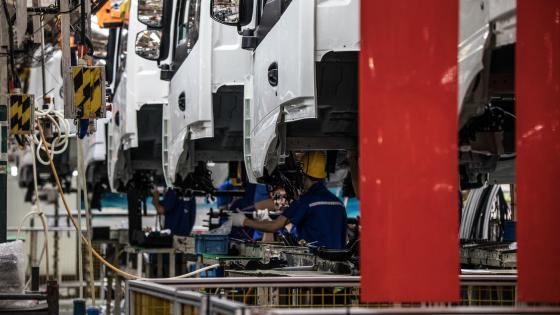China’s rapid economic growth has led to a spate of comparisons between the sizes of the economies of China and the US. Authors wishing to make China look big use exchange rates adjusted for local prices.
Frankel (2014) argues that GDP converted at market exchange rates is a better measure of economic power since international spending power but not local spending power is what matters. Specifically, comparisons based on market exchange rate are appropriate for measuring the importance of a country in the world economy, such as the national share of world demand, the impact on financial markets, and international voting rights.
- As Frankel notes, since the market exchange rate is approximately half the value of the purchasing power parity (PPP) exchange rate, the US remains the world’s largest economic power by a substantial margin.
But another aspect of China’s rise is its rising military strength. Its military budget has grown at double digit rates for 20 years. The wider political economy implications of China’s rise also depend on this military muscle (Mearsheimer 2006, Friedberg 2011, Kaplan 2014). As evidenced by Obama’s ‘pivot to Asia’, this is already changing the balance of power in Asia, and the US foreign policy response (Clinton 2011, The Economist 2012).
But how should we compare this spending in RMB to the US military budget? Will market exchange rates or PPP exchange rates give a more accurate comparison of relative real military spending in each country?
Military spending in China and the US
In a recent paper, (Robertson and Sin 2015), we show that China’s military budget was 18% of that of the US using market exchange rate comparisons, but 33% of the one of the US using PPP exchange rates. In addition, China spends only around 2% of its GDP on the military, compared to 5% by the US. If China raised its military spending to GDP ratio to the US level, it would be close to par with the US in PPP terms, but still far behind it in terms of market exchange rates.
Such large differences due to exchange rate choices cause anxiety in the Pentagon. It is a ‘known unknown’ that has been flagged many times by, for example, the Rand Corporation, the US Department of Defence, and military statistical abstracts such as the IISS and SIPRI (Crane et al. 2006, US Department of Defence 2011, IISS 2012, SIPRI 2012).
Frankel also points out that the market exchange rate matters for military power. He gives the example of China’s ability to project power in the South China Sea, which depends on its ability to purchase naval capacity. Likewise, China imports the latest generation anti-ship missiles from Russia.
But military spending more generally has a large domestic component. Around 1/3 of China’s military budget is spent on personnel – all of whom are paid substantially lower wages than their US equivalents – even after adjusting for differences in training. So, in this case it is not obvious whether market exchange rates or PPP exchange rate comparisons give a more accurate perspective.
A military unit cost exchange rate
The correct exchange rate with which to compare military spending would be a price or unit cost ratio of military services in each country. We, therefore, tackle this problem by developing Tornqvist and Fisher price indices applied to data on broad military budget shares for personnel, equipment, and operations spending.
In accordance with Frankel’s arguments above, we use market exchange rates as a measure of relative military equipment costs facing each country since most equipment, or close substitutes, is tradable. For relative operations costs, however, we use PPP exchange rates as a reasonable proxy since the operations budget represents a bundle of traded and non-traded goods and services.
Finally, relative personnel costs are obtained using manufacturing wages, either gross or net of on-costs, since this represents the social opportunity cost of military employment.
Even after adjusting for differences in average schooling, we find that these differences in personal costs are very large. Because of this, our resulting relative military cost (RMC) exchange rates are very low. Thus, while the market exchange rate in 210 was around 6.8 RMB per dollar, and the PPP exchange rate was 3.7 RMB per dollar, we obtain a relative military cost exchange rate of 2.9 RMB per dollar.
This low relative military costs exchange rate implies a real value of China’s military spending of 40% of the US in real terms – larger than the level implied by using PPP rates of 33%, and much larger than the market exchange rate based figure of 18%. Moreover, if both countries spent the same fraction of their GDP on the military, the relative size of China’s military machine is over 90% of the one of the US.
One strength of our method is that it allows for the fact that the US uses more equipment-intensive techniques and China uses labour-intensive techniques. Thus, it avoids substitution bias associated with fixed basked approaches. Moreover, it can also be readily calculated with minimal data.
One caveat is that the method assumes the technology for combing inputs –but not the inputs choice – is the same in both countries. But even allowing for say, a 10%-20% productivity advantage in the US due, for example, to less corruption and better procurement practices, it would still leave a very large estimate of real spending that would be closer to the PPP estimate of China’s military spending.
Conclusion
We find that converting China’s military spending in RMB to dollars using market exchange rates will dramatically understate its real size. A more realistic assessment shows that China’s real spending is closer to the value implied by PPP exchange rates.
This economic measure of military strength is important because it shows that China has the potential to match the US in certain military spheres with a similar burden on its economy. This is in stark contrast to the Soviets’ cold war strategy, where they matched the US only by spending up to 20% of GDP on the military.
So, in terms of military spending, China is ‘number 2’ but only by a small and shrinking margin. This will matter a great deal in terms of its ability to enforce territorial claims and achieve its foreign policy objectives. In these terms, China’s ability to wield international political power would seem to be very close to that of the US.
Editor's note: The author gratefully acknowledges the hospitality of St Anthony's College, Oxford and the CSAE, Oxford University.
References
Clinton, H (2011), “America’s Pacific Century”, Foreign Policy, 189, (1): 56-63.
Crane, K, R Cliff, E Medeiros, J Mulvenon, and W Overholt (2005), Modernizing China’s Military, Opportunities and Constraints, Rand Corporation, Santa Monica, California.
Frankel, J (2014), “China is Not Yet Number One”, VoxEU.org, 9 May.
Friedberg, A L (2011), A Contest for Supremacy: China, America, and the Struggle for Mastery in Asia, WW Norton, New York.
International Institute for Strategic Studies (IISS) (2012), The Military Balance 2012, International Institute for Strategic Studies, London.
Kaplan, R D (2014), Asia’s Cauldron: The South China Sea and the End of a Stable Pacific, Random House.
Mearsheimer, J J (2006), “China’s unpeaceful rise”, Current History, 105, (690): 160-162.
Stockholm International Peace Research Institute (SIPRI) (2012), SIPRI Yearbook 2012: Armaments, Disarmament and International Security, Oxford University Press.
The Economist (2012), “China’s military rise: The Dragon’s New Teeth. A Rare Look Inside the World’s Biggest Military Expansion”, 403, (8779): 27.
Robertson, P E and A Sin (2015), "Measuring Hard Power: China's Growth and Military Capacity", Defence and Peace Economics (forthcoming).
U.S. Department of Defense (2011), Military and Security Developments Involving the People’s Republic of China, Office of the Secretary of Defense, Annual Report to Congress.


